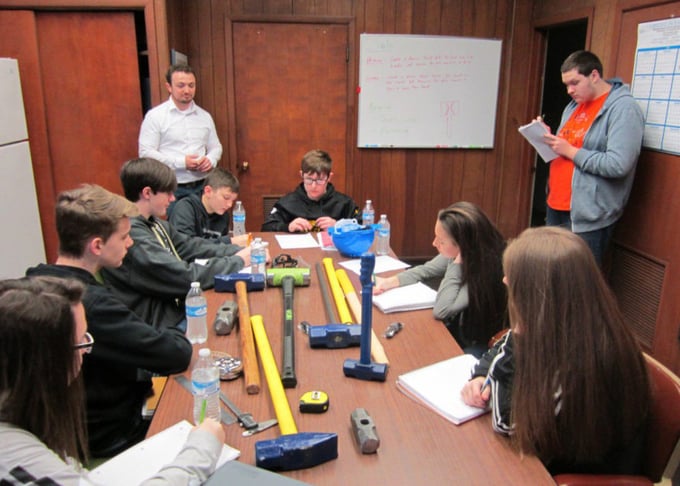Katie Dantrassy is an assistant principal at John Marshall High School in Glen Dale, West Virginia. Her background is in English and gifted education, and she works as an advocate for STEM and technological innovation in the high school curriculum.
Why would a group of high school students be ordering a log splitter?
The assignment all started with two brothers meeting in their basement to watch a ball game. Mr. Gavin Hartle, John Marshall High School’s PLTW Engineering teacher, was spending some quality family time with his brother Logan, who just happened to be CEO of a growing manufacturing company named Warwood Tool. Logan Hartle and his business partner, Phil Carl, needed a new method to test the durability of different sledgehammers so that they could quantify the quality of their product. Listening to Logan and Phil talk, Mr. Hartle knew that was a challenge his class could tackle.
Shortly thereafter, Introduction to Engineering Design (IED) students were touring Warwood Tool and listening to the needs of the company owners. After taking notes and learning about the company’s mission, the students took their work to the drawing board. They designed whatever they could dream. The groups knew that the hammer tester would need a pressure sensor, mechanisms to protect the people using it, and an economical supply list for the build.
Ideas were flying. Mr. Hartle was true to his word when he told students that no ideas were “ridiculous” and that all ideas had merit to the creative process. He acknowledged students who considered tank components, wires and pulleys, and wall anchors as parts of their innovative solutions. So when a team member threw out the idea for innovating a log splitter, a collective light bulb went on. For the team, it was the perfect solution for an economical build and use of pneumatics. Because the other group was still unsure, students collaborated in using the decision matrix to objectively evaluate their options, something that is standard in the industry.
The students quickly agreed to go forward with the modification and innovation after designing the build and reviewing safety protocols for the build and use. They moved forward with blueprints and digital designs.
Luckily, Mr. Hartle and I were able to support this project thanks to the generosity of Chevron through the Education Alliance. With their backing, students ordered their pressure sensors, general materials, and log splitter, meeting their ideal specifications.
Mr. Hartle invited his brother and business partner back to our school, and we arranged for a community panel and newspaper to listen to the students pitch their innovation for a hammer pull to their clients. As the students filed into the conference room, each face was alight with the power of relevance and importance. They used our school’s professional touchscreen presentation board to showcase their ideas and drawings. They fielded questions about their process and ideas for the design, ultimately scoring the approval and awe of our industry design partners.
Warwood Tool was so impressed they asked to continue our design partnership. The students were overwhelmed by their feedback and felt that they had truly accomplished something real. They listened intently as the owners of Warwood Tool explained how they built their own business after graduating from John Marshall and West Virginia University, and the students reveled in the praise that these two men had not encountered the types of calculations and design work that they had accomplished until their sophomore year of college.
Even though students were working hard in the classroom and using real-world technologies and problems, completing this task made them realize the value and advanced nature of their work. Mr. Hartle and I reflected on the process of this design challenge from the school and classroom perspective. We gained a valued partner that is interested in our graduates and ideas. We saw students who previously did not see a reason to participate in school perk up and take the lead. Finally, we saw truth in telling our students to stop waiting for their futures to change the world and to start now.
PLTW’s blog is intended to serve as a forum for ideas and perspectives from across our network. The opinions expressed are those of each guest author.

